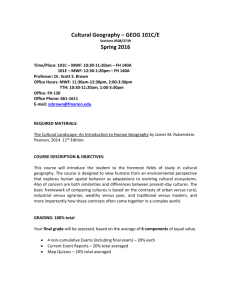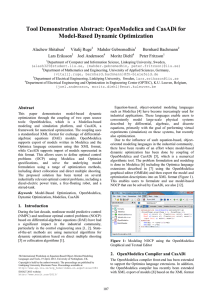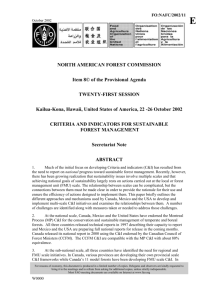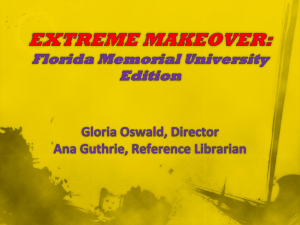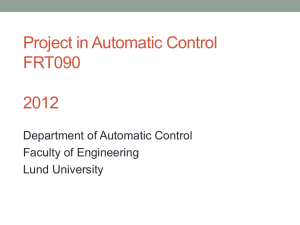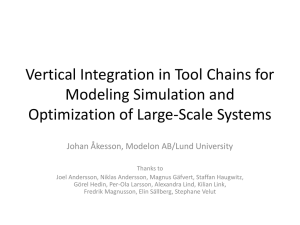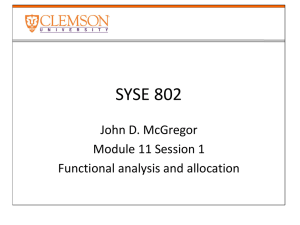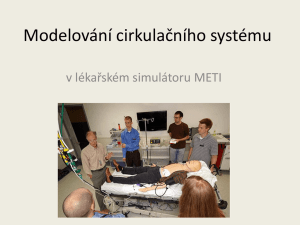A Generic FMU Interface for Modelica Wuzhu Chen Michaela Huhn Peter Fritzson
advertisement
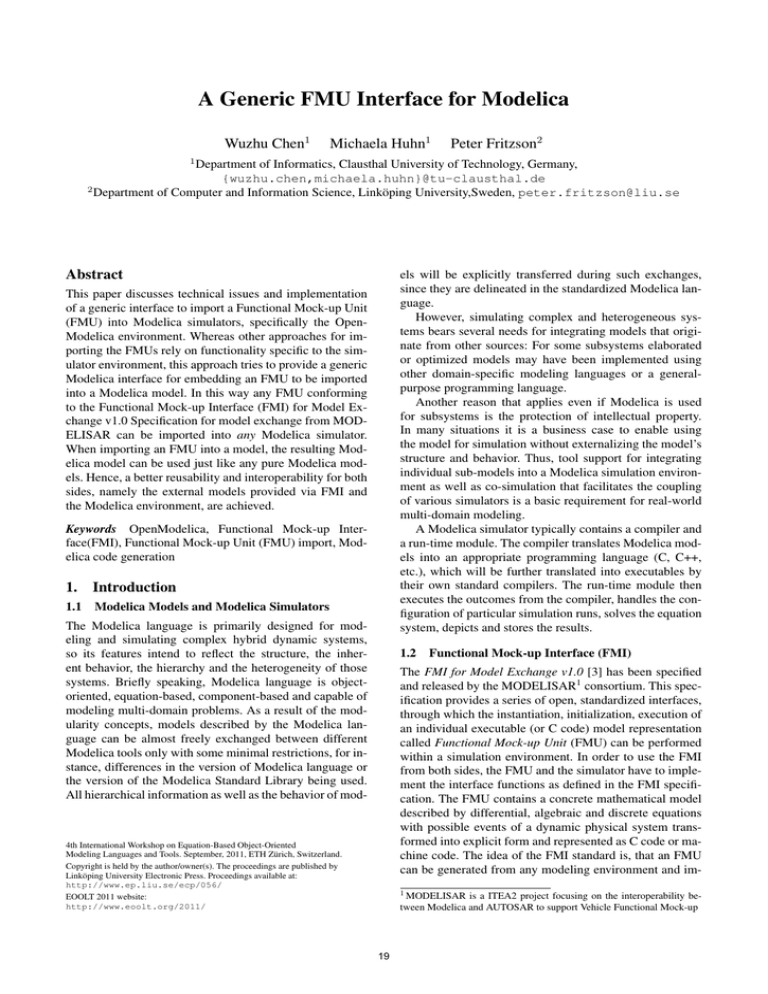
A Generic FMU Interface for Modelica
Wuzhu Chen1
Michaela Huhn1
Peter Fritzson2
1
Department of Informatics, Clausthal University of Technology, Germany,
{wuzhu.chen,michaela.huhn}@tu-clausthal.de
2
Department of Computer and Information Science, Linköping University,Sweden, peter.fritzson@liu.se
Abstract
els will be explicitly transferred during such exchanges,
since they are delineated in the standardized Modelica language.
However, simulating complex and heterogeneous systems bears several needs for integrating models that originate from other sources: For some subsystems elaborated
or optimized models may have been implemented using
other domain-specific modeling languages or a generalpurpose programming language.
Another reason that applies even if Modelica is used
for subsystems is the protection of intellectual property.
In many situations it is a business case to enable using
the model for simulation without externalizing the model’s
structure and behavior. Thus, tool support for integrating
individual sub-models into a Modelica simulation environment as well as co-simulation that facilitates the coupling
of various simulators is a basic requirement for real-world
multi-domain modeling.
A Modelica simulator typically contains a compiler and
a run-time module. The compiler translates Modelica models into an appropriate programming language (C, C++,
etc.), which will be further translated into executables by
their own standard compilers. The run-time module then
executes the outcomes from the compiler, handles the configuration of particular simulation runs, solves the equation
system, depicts and stores the results.
This paper discusses technical issues and implementation
of a generic interface to import a Functional Mock-up Unit
(FMU) into Modelica simulators, specifically the OpenModelica environment. Whereas other approaches for importing the FMUs rely on functionality specific to the simulator environment, this approach tries to provide a generic
Modelica interface for embedding an FMU to be imported
into a Modelica model. In this way any FMU conforming
to the Functional Mock-up Interface (FMI) for Model Exchange v1.0 Specification for model exchange from MODELISAR can be imported into any Modelica simulator.
When importing an FMU into a model, the resulting Modelica model can be used just like any pure Modelica models. Hence, a better reusability and interoperability for both
sides, namely the external models provided via FMI and
the Modelica environment, are achieved.
Keywords OpenModelica, Functional Mock-up Interface(FMI), Functional Mock-up Unit (FMU) import, Modelica code generation
1.
Introduction
1.1
Modelica Models and Modelica Simulators
The Modelica language is primarily designed for modeling and simulating complex hybrid dynamic systems,
so its features intend to reflect the structure, the inherent behavior, the hierarchy and the heterogeneity of those
systems. Briefly speaking, Modelica language is objectoriented, equation-based, component-based and capable of
modeling multi-domain problems. As a result of the modularity concepts, models described by the Modelica language can be almost freely exchanged between different
Modelica tools only with some minimal restrictions, for instance, differences in the version of Modelica language or
the version of the Modelica Standard Library being used.
All hierarchical information as well as the behavior of mod-
1.2
Functional Mock-up Interface (FMI)
The FMI for Model Exchange v1.0 [3] has been specified
and released by the MODELISAR1 consortium. This specification provides a series of open, standardized interfaces,
through which the instantiation, initialization, execution of
an individual executable (or C code) model representation
called Functional Mock-up Unit (FMU) can be performed
within a simulation environment. In order to use the FMI
from both sides, the FMU and the simulator have to implement the interface functions as defined in the FMI specification. The FMU contains a concrete mathematical model
described by differential, algebraic and discrete equations
with possible events of a dynamic physical system transformed into explicit form and represented as C code or machine code. The idea of the FMI standard is, that an FMU
can be generated from any modeling environment and im-
4th International Workshop on Equation-Based Object-Oriented
Modeling Languages and Tools. September, 2011, ETH Zürich, Switzerland.
Copyright is held by the author/owner(s). The proceedings are published by
Linköping University Electronic Press. Proceedings available at:
http://www.ep.liu.se/ecp/056/
EOOLT 2011 website:
http://www.eoolt.org/2011/
1 MODELISAR
is a ITEA2 project focusing on the interoperability between Modelica and AUTOSAR to support Vehicle Functional Mock-up
19
the model exchange and to glue all these benefits together is
a tool-independent, uniform interface from FMUs to Modelica models, which can be also distributed along with the
FMUs for potential use by Modelica modelers. Thus, the
model exchange facility indeed crosses the boundary of
simulators in the Modelica context.
ported into any simulation environment whenever the compliance with FMI specification for model exchange is fulfilled.
Technically, a generated FMU will be distributed as a
compressed .fmu file basically consisting of two parts. The
first part is the model interface functions according to the
FMI specification. They can be given either in C source
code or in binary forms (e.g. in the form of .dll or .so files)
to protect the model developers’ intellectual property. The
second part is the model description XML file, conforming
to the schema defined in the FMI specification. The XML
file contains all information about the model variables and
some other optional information. Additional parts can be
added and compressed into the FMU, as for instance the
documentation and the icon of the model. Compared to
the exchange of Modelica models, exchanging of FMUs
is at a lower abstraction level and more target-oriented,
and consequently less flexible due to the export and import
procedures and the conversion of acausal Modelica models
to causal explicit form.
1.3
The rest of the paper is organized as follows: In Section 2, the implementation of the generic interface are presented in detail. In section 3, a case study of a hybrid dynamic system is investigated and the results are analyzed
in OpenModelica environment. At the end in Section 4, the
conclusions of this FMU import approach are given.
Implementation of the Interface
2.1
Overview of the Implementation
As already mentioned in the introduction Section 1, we aim
at a generic interface for importing FMUs into Modelica
models in a way that any FMUs can be directly evaluated
and simulated in any Modelica simulator. Thus the key issue is to decouple the FMU import process from specific
Modelica simulator implementations. Most of the FMU
interface functions will be mapped to Modelica external
functions bijectively. Some extra Modelica helper classes
and functions are also implemented to perform additional
tasks, for example type conversion, special construct instantiation, message printing and so on. The imported FMU
itself is represented as a Modelica class through the extension of an external object with variable information from
parsing the model description XML file. In this way, multiple instances of this FMU can be easily declared and connected with models that are described in Modelica.
The import process contains following key steps
State of the Art for FMU Import
Currently, some Modelica simulators already support FMU
import, for example SimulationX ® , Dymola ® , and the
open source tool JModelica.org2 , and some others. Although the FMI interface is vendor neutral, the implementations of import of the FMU realized by the above mentioned simulator tools are not. Either the import of FMU
is implemented on the basis of some specific programming language [1], Python in this case, or the Modelica
language is internally extended [4] because the Modelica
language lacks support for the full range of functionalities
specified in FMI. However, since each tool vendor offers
a proprietary implementation of FMU import, we are actually keeping reinventing the wheel in the sense of multiple
implementations of FMU import. Moreover, there still exists some additional difficulties in the FMI specification of
FMU import that hamper the proliferation of the FMI standard in practice, for example the lack of support of multiple
instances of FMU models generated by some simulation
tool, the lack of coupling of imported FMUs with Modelica models, to name just some of them.
1.4
2.
• To extract the archived .fmu file in some specified folder
• To parse the model description file for model informa-
tion
• To load the library file or include the source file if
provided
• To integrate the functions and the variable information
into a Modelica block
Motivation for a Generic FMU Interface to
Modelica
Summing up these aspects, the concept of the implementation of FMU import is illustrated in Figure 1.
As discussed before, the benefits of a standardized interface
for model exchange are widely agreed and have led to the
FMI specification by MODELISAR. But furthermore there
is also a need for a generic and uniform implementation
of the import functionality for Modelica tools. A holistic
modeling of a heterogeneous system may incorporate the
combined simulation of Modelica models and a number
of imported FMUs within several Modelica simulators. In
this way, the systematic behavior of the total system can be
analyzed without revealing the modeling know-how embedded of the FMU components. A key role to generalize
FMU
unzip
Model
Description
parser
Variable
Information
Model
Interface
wrapper
fmuWrapper.c
.mo generator
Modelica
Model
2 JModelica.org
is an open source Modelica simulation environment tailored for optimization problems. For more information please refer to
http://www.jmodelica.org
Figure 1. An overview of FMU import.
20
2.2
Details of the Prototype Implementation
1
2
A prototype of the generic FMU interface for Modelica
has been implemented and tested in the OpenModelica
environment. The details of the implementation are going
to be discussed in this section.
Even in the open-source domain, we find numerous
possibilities for the decompression of a .fmu archive file,
e.g. zlib, gzip, PowerArchiver, 7-zip, etc. Since this step is
rather trivial compared to the others, it will not be discussed
further.
After having decompressed the archive file, the model
description XML file and the model interface implementation are stored in a specified directory, e.g. in OpenModelica under Microsoft Windows® the directory will be
"<OPENMODELICAHOME> \tmp\fmu". Information
about model variables and other additional information can
be extracted from the XML file by an appropriate XML
parser, we will use the parser in the libxml2 library provided by the OpenModelica environment.
For the current prototype, the model interface implementation is supposed to be a shared dynamic link library
(DLL). By successfully parsing the XML and loading the
DLL, the handle of the DLL, the addresses of the exported
interface functions and the information data from the XML
file are stored in a data structure called FMI, which is defined in a wrapper header file. The instantiation of this
structure in Modelica is achieved by a class, which extends
the Modelica External Object as shown below.
3
4
5
6
7
8
9
10
11
12
13
14
15
16
17
18
19
There are 24 standard interface functions defined in the
FMI specification v1.0. Most of them are wrapped in the
fmuWrapper.c and then mapped one-to-one into Modelica external functions with a slight difference in naming
convention to indicate the wrapped functions are not the
implementation of FMI but exclusive for FMU import. For
instance, the fmiGetDer(...) in C
1
2
3
4
1
2
3
4
5
6
7
8
9
10
11
12
13
14
class fmuModelInst
extends ExternalObject;
function constructor
input fmuFunctions in_fmufun;
input String in_instName;
input String guid;
input fmuCallbackFuns functions;
input Boolean logFlag;
output fmuModelInst inst;
external "C" inst=fmiInstantiate(in_fmufun,
in_instName,guid,functions,logFlag)
annotation(Include="#include <fmuWrapper.c>");
end constructor;
function destructor
input fmuModelInst in_inst;
external "C" fmiFreeModelInst(in_inst)
annotation(Include="#include <fmuWrapper.c>");
end destructor;
end fmuModelInst;
class fmuFunctions "List of interface functions"
extends ExternalObject;
function constructor
input String dllPath;
output fmuFunctions fmufun;
external "C" fmufun = instantiateFMIFun(dllPath)
annotation(Include = "#include <fmuWrapper.c>");
end constructor;
function destructor
input fmuFunctions fmufun;
external "C" freeFMIFun(fmufun)
annotation(Include = "#include <fmuWrapper.c>");
end destructor;
end fmuFunctions;
5
6
7
8
9
10
will be mapped in Modelica as the following snippet:
1
2
3
4
An FMU is represented as a Modelica class called
fmuModelInst in the prototype. In the generic interface, the detailed structure of this class is however hidden behind the so-called Modelica External Object. Consequently, the internal structure of the instance cannot be
accessed and manipulated directly by Modelica. Provided
the necessary inputs are given in Modelica, the instance of
an FMU can be declared and immediately instantiated, e.g.
void fmiGetDer(void* in_fmi, void* in_fmu,
double* der_x, size_t nx, const double* x){
FMI* fmi = (FMI*) in_fmi;
fmiStatus status;
if(fmi->getDerivatives){
status = fmi->getDerivatives(in_fmu,der_x,nx);
if(status>fmiWarning){
printf("fmiGetDerivatives(...) failed...\n");
exit(EXIT_FAILURE);} }
return; }
5
6
7
8
9
function fmuGetDer "calculate the derivatives"
input fmuFunctions fmufun;
input fmuModelInst inst;
input Integer nx;
input Real x[nx];
output Real der_x_out[nx];
external "C" fmiGetDer(fmufun,inst,der_x_out,nx,x)
annotation(Include = "#include <fmuWrapper.c>");
end fmuGetDer;
fmuModelInst inst=fmuModelInst(argument_list);.
Later on, this instance reference may be passed as an argument to some external code for various purposes such as
data updating, data evaluation, memory freeing, etc. In fact,
the actual instantiation is done by calling the external C
function fmiInstantiate(...) defined in the constructor section of the class fmuModelInst, see the following
Modelica code for details:
2.3
Implementation of FMI Calling Sequence
The UML 2.0 compliant state machine in Figure 2 shows
the calling sequence of the interface functions specified in
FMI for Model Exchange v1.0. This calling sequence has
to be implemented in the prototype in Modelica as well.
21
Functional Mock-up Interface for Model Exchange
MODELISAR (ITEA 2 - 07006)
January 26, 2010
Page 22 of 56
2.9. State Machine of Calling Sequence
Every implementation of the FMI must support calling sequences of the functions according to the
following state machine:
block FMUBlock "a prototype"
output Real y[ny];
3
input Real u[nu];
4 protected
5
constant String dllPath="fmu\\bouncingBall
6
\\binaries\\win32\\bouncingBall.dll";
7
constant String instName="bouncingBall";
8
constant String guid=
9
"{9d95f943-e636-4f71-8d7d-6f54c4128f13}";
10
parameter Boolean logFlag=false,tolControl=true;
11
parameter Integer nx = 2;
12
parameter Integer ni = 1;
13
replaceable parameter Real relTol = 0.0001;
14
replaceable Real x[nx](start={1.0,0.0}),der_x[nx];
15
Real out_x[nx],out_der_x[nx];
16
...
17
fmuModelInst inst=fmuModelInst(fmufun,instName,
18
guid,functions,logFlag);
19
fmuEventInfo evtInfo = fmuEventInfo();
20
...
21
fmuFunctions fmufun = fmuFunctions(dllPath);
22
fmuCallbackFuns functions = fmuCallbackFuns();
23
initial algorithm
Figure 4: Calling sequence of Model Exchange C-functions in form of an UML 2.0 state machine.
Figure 2. Calling sequence of interface functions[3].
24
fmuSetTime(fmufun, inst, time);
If a transition is labelled with one or more function names (e.g. fmiGetReal, fmiGetInteger) this means
that the transition is taken if any of these functions is successfully called. The transition conditions "step
25
fmuInit(fmufun,inst,tolControl,relTol,evtInfo);
event", "time event", and "state event" are defined in section 2.1. Each state of the state machine
26
x:=fmuGetContStates(fmufun, inst);
corresponds to a certain phase of a simulation as follows:
A schematic view of communication between an FMU
27
algorithm
instantiated:
instance
and the environment is also given in the FMI
28
der_x:=fmuGetDer(fmufun, inst, x);
In this state, inputs, start and guess values can be set.
Functional Mock-up Interface for Model Exchange
29
equation
Specification
in Figure 3. In this figure,
it
is
shown
that
stepAccepted:
MODELISAR (ITEA 2 - 07006)
In this state, the solution at initial time, after a completed integrator
step,
or2010
after event iteration can be
30
der(x) = der_x;
January
26,
different
kinds of variables are defined
to
describe
the
state
retrieved. If fmiInitialize or fmiEventUpdate return withPage
eventInfo.terminated
= fmiTrue, a
31
algorithm
6 of 56
transition
to
state
“terminated”
occurs.
of an FMU and the information flowing into\out of an
32
fmuSetContStates(fmufun, inst, x);
stepInProgress:
FMU.
33
fmuCompIntStep(fmufun, inst, stepEvt);
In this state, an integrator step is performed. Also, the event time of a state event may be determined here
34
prez:=z;
35
z:=fmuGetEventInd(fmufun, inst, ni);
v
t0 , p,inital values (a subset of {x 0 , x0 , y 0 , v 0 , m 0 })
36
fmuStateEvtCheck(stateEvt, ni, z, prez);
Enclosing Model
37
fmuEvtUpdate(fmufun,inst,evtInfo,timeEvt,
38
stepEvt,stateEvt,interMediateRes);
t time
39
...
m discrete states (constant between events)
40
when zeroCrossing<0 then
p parameters of type Real, Integer, Boolean, String
41
reinit(x[1], out_x[1]);
u inputs of type Real, Integer, Boolean, String
u
y
42
reinit(x[2], out_x[2]);
v all exposed variables
x continuous states (continuous between events)
43
...
y outputs of type Real, Integer, Boolean, String
44
end when;
z event indicators
45 end FMUBlock;
External Model (FMU instance)
1
2
t
x , m, z
x
2.4
Other Technical Issues
In the FMI Specification v1.0, the fmiCallbackFunctions is
defined as a struct containing function pointers provided
Figure 1: Data flow between the components
by the environment. In Modelica there is no correspondBlue arrows: Information provided by the FMU.
ing record to store information about function pointers.
Red arrows: information provided to the FMU.
Nevertheless, Modelica provides the external object conFigure
3.
Data
flow
for
information
exchange[3].
struct, which allows the user to define and access his or
1.1. Properties and Guiding Ideas
her
In this section, properties are listed and some principles are defined that guided the low-level design
of own external data structures. Thus it is possible to dethe Model Exchange
interface.
This shall
increase
self consistency
of thefunction
interface functions.
clare a subclass of this ExternalObject to instantiate and
In order
to satisfy
the
requirements
of the
call- The listed
issues are sorted, starting from high-level properties to low-level implementation issues.
de-instantiate the fmiCallbackFunctions data structure via
ing sequence and the data exchange of an FMU, a suitExpressivity: The FMI provides the necessary features that Modelica®, Simulink® and SIMPACK models
able
construct
in
Modelica
should
be
defined
and
stanexternally defined C functions.
can be transformed to an FMU.
dardized. Despite the fact that Modelica is primarily deThe FMI specification also states that some functions,
Implementation: FMUs can be written manually or can be generated automatically from a modelling
signed
as
a
modeling
language
based
on
acausal
equation
such
as fmiInitialize(...), should be called only once, but
environment. Existing manually coded models can be transformed manually to a model
according
to the FMI
standard. does offer non-declarative algorithsystems[2],
Modelica
this can not be ensured by the Modelica simulation enviProcessormic
independence:
It is possible
to distribute
an FMUmethods
without knowing
processor. This
constructs,
in which
procedural
maythe
betarget
called
ronment, because during the initialization phase the runallows to run an FMU on a PC, a Hardware-in-the-Loop Simulation platform or as part of the
in a specific order. Due to the arguments discussed pretime module may traverse the initial algorithm seccontroller software of an ECU, e. g. as part of an AUTOSAR SW-C. Keeping the FMU
viously,
the
calling
sequence
and
specific
data-flows
can
independent of the target processor increases the usability of the FMU and is even requiredtion
by several times. A solution to solve this issue is to define
thebe
AUTOSAR
software
model.
Implementation:
using a textual
C as an initialization indicator in the above mentioned
realized
as acomponent
Modelica
block
incorporating
withFMU
in-(distribute atheflag
source of the FMU).
ternal variables, input\output signals, algorithm and
class fmuFunctions. Whenever this flag records a call
Simulator independence: It is possible to compile, link and distribute an FMU without knowing the target
for initialization, the fmiInitialize(...) will not be called
equation sections. A snippet of such a Modelica block is
simulator. Reason: The standard would be much less attractive otherwise, unnecessarily
given
below
for
illustration.
restricting the later use of an FMU at compile time and forcing users to maintain simulator again.
Solver
2
specific variants of an FMU. Implementation: using a binary FMU. When generating a binary
2
Modelica is a registered trademark of the Modelica Association, Simulink is a registered trademark of the MathWorks Inc.,
SIMPACK is a registered trademark of SIMPACK AG.
22
Since the predefined type Boolean in Modelica and
fmiBoolean in FMI are implemented differently in terms of
C types, when importing an FMU into most Modelica simulators, the conversion between these two types needs to
be considered carefully. The former, i.e. the Boolean type,
corresponds to unsigned char in C in the OpenModelica
context. The latter, i.e. the fmiBoolean in FMI, corresponds
to char in C. As a consequence, external functions have
been implemented in the wrapper to perform the necessary
bi-directional conversions and these functions can be called
directly from Modelica.
Connecting imported FMU blocks together hierarchically might arise the difficulty in determining the correct
call sequence of setter and getter methods in FMUs for input and output signals. A general alternative is to determine the call sequence according to the connection graph
based on some causal relationships between these signals.
As soon as the call sequence has been sorted, flags associating with the setter or getter methods can be added in
the argument list to indicate the correct order. In this paper, since the imported FMUs are transformed into Modelica models, the correct call sequence of setter and getter
methods of input and output signals can be automatically
determined by the Modelica simulation environment, [3] in
Appendix B.5.
2.5
soon. After the translation from an FMU to a Modelica
model, any instances of this FMU can now be declared as "
FMUBlock fmu1,fmu2,...; " and connected with other
Modelica models. Such capabilities are shown below about
the the Bouncing Ball case study.
In the case study discussed in Section 3, the only kind
of events are state events. The state event is triggered by
the simulation environment outside the FMU model via the
FMUBlock. The function fmuStateEvtCheck(...) will
check for the state event and return information through the
formal fmiBoolean parameter stateEvt. If a state event
occurs, the fmuEvtUpdate(...) is called and updates
the states accordingly. Other events, such as time events
and step events, might also occur during simulations of
dynamic systems, but they are not covered in the case study
Bouncing Ball.
3.
Case Study: Bouncing Ball
The bouncing ball example is a good candidate to show the
behavior of a hybrid dynamic system and the capability of
event handling in the presented FMU import prototype. The
bouncing ball FMU is generated using the free software
development kit FMU SDK provided by QTronic GmbH.
[5]
Difficulties in the Implementation
3.1
Some functionalities defined in FMI specification cannot
be mapped directly into Modelica without specific treatment.
FMI functions fmiCompletedIntegratorStep, fmiEventUpdate and fmiTerminate are not constant functions, so
they do not behave as mathematical functions and there
might be a need to mark these functions as "impure" in
Modelica via some extension to the language.
The FMI function fmiCompletedIntegratorStep cannot
be defined and called properly in Modelica, since Modelica language does not provide the functionalities, through
which the status of a integration step can be queried and
when an integrator step is finished can be detected.
When calling the FMI function fmiGetEventIndicators
from Modelica model, it will introduce the hysteresis twice
to the event indicators. According to the FMI specification,
FMUs will add a small hysteresis to the event indicators to
avoid event "chattering". And a Modelica tool will do the
same when calculating the "zero crossing". So the resulted
event triggered by the imported FMU is slightly inaccurate.
This problem can be solved by calling external functions,
e.g. fmuStateEventCheck(...), which will check the
events according to the current values and the previous
values of the event indicators given as function arguments.
This paper focuses mainly on FMU import in OpenModelica environment, some of these tricky issues requiring specific treatments are temporarily handled in OpenModelica.
Multiple Instances of an FMU
As mentioned previously, multiple instances of an FMU
block can be easily created as below by the standard variable declaration in Modelica. Furthermore, modifications
can also be applied to the declared variables e.g.:
1
2
3
4
5
model FMUMultipleInstance
FMUBlock fmu1,fmu2(redeclare parameter Real
relTol = 0.002, redeclare Real x[nx]
(start = {2.0,0.0}));
end FMUMultipleInstance;
The simulation results of the Modelica code above in OpenModelica 1.7.0 are illustrated in Figure 4, which shows the
expected property of multiple instances of an FMU block.
In the presented prototype, the Modelica model is partially automatically generated by the code generator. A full
automation of the generation process will be completed
Figure 4. Results of multiple instances of an FMU
23
3.2
Connection with another Modelica Model
ioral languages, e.g. VHDL-AMS, provided they support
some mechanism to access external functions.
However, the following fundamental requirements need
to be satisfied to facilitate FMU import. Obviously, for the
generic FMU interface for Modelica to work properly, the
provided FMU needs to be fully compliant with the FMI
for Model Exchange v1.0 Specification. For instance, the
FMUs generated from Dymola® 7.4 do not support multiple instances of an FMU at the moment. Secondly, the
simulator must not modify the generated Modelica models
during loading the FMU block, which is not guaranteed by
some simulators. Some simulators adapt the loaded Modelica code according to their specific rules, which creates
problems in this situation. And thirdly, but not last, the construction of the Modelica External Object construct has to
be well supported by the simulator.
A simple connection between an FMU instance and a nonlinear block from the Modelica Standard Library 3.1 (MSL
3.1) is shown in Figure 5. From the user perspective, the
connection between an FMU instance and any Modelica
models becomes nearly trivial when using our generic interface. The Modelica code is:
1
2
3
4
5
6
7
model FMUConnection
FMUBlock fmu;
Modelica.Blocks.Nonlinear.VariableDelay vd
(delayTime = 0.2);
equation
vardelay.u = fmu.x[1];
end FMUConnection;
and the simulation result from OpenModelica is given in
Figure 5, which also produced the expected delay of the
input signal.
Acknowledgments
This work is funded by the Federal Ministry of Education
and Research (BMBF), Germany, in the ITEA2 project
OPENPROD (grant 01|S09029D).
We are also thankful to Martin Sjölund and Mohsen
Torabzadeh-Tari from Linköping University for the productive discussions on this topic.
References
[1] Christian Andersson, Johan Åkesson, Claus Führera, and
Magnus Gäfvert. Import and Export of Functional Mockup Units in JModelica.org. In Proceedings of 8th Modelica
Internationl Conference. Modelica Consortium, 2011.
[2] Peter Fritzson. Principle of Object-Oriented Modeling and
Simulation with Modelica 2.1. WILEY-INTERSCIENCE,
2003.
[3] MODELISAR. Functional Mock-up Interface for Model
Exchange 1.0. http://www.functional-mockup-interface.org.
Figure 5. Results of connection between an FMU instance
and Modelica model
4.
[4] Christian Noll, Torsten Blochwitz, Thomas Neidhold, and
Christian Kehrer. Implementation of Modelisar Functional
Mock-up Interfaces in SimulationX. In Proceedings of
8th Modelica Internationl Conference, Webergasse1, 01067
Dresden, Germany, 2011. Modelica Consortium.
Conclusions and Outlook
In this paper, we presented the concept of a generic interface in Modelica and a prototypical implementation. The
interface enables multiple instances of an imported FMU
and a simple connection between FMU instances and Modelica models. Of course, any properties provided by the
Modelica modeling language, e.g. inheritance, modification, extension and so on, can be applied to the FMU block
and its declared variables. The approach presented here
fills the gap between the vendor-neutral FMI for model
exchange and currently existing vendor-dependent FMU
import implementations. An obvious drawback of our approach is the the higher memory consumption compared to
simulating a pure Modelica model or simulating an FMU
in a stand-alone simulator, because storages have to be assigned for both Modelica objects and FMU instances. Future work includes more test cases of the prototype, full
automation of the code generation and tuning to support
other Modelica simulators. It is also worth mentioning that
FMI specification is not Modelica specific, so a similar approach for FMU import may be checked with other behav-
[5] QTronic. FMU SDK (FMU Software Development Kit).
http://www.qtronic.de/de/fmusdk.html.
24
